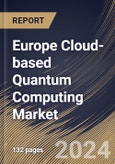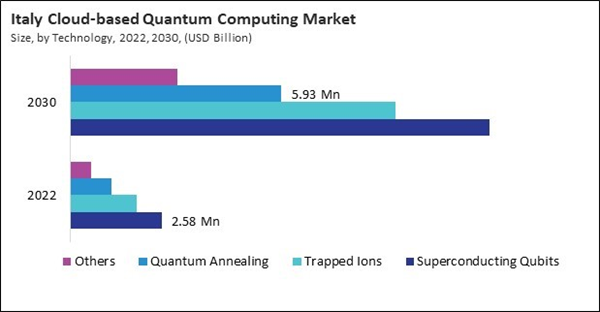The Germany market dominated the Europe Cloud-based Quantum Computing Market by Country in 2022, and would continue to be a dominant market till 2030; thereby, achieving a market value of $134.2 million by 2030. The UK market is exhibiting a CAGR of 18.4% during (2023 - 2030). Additionally, The France market would experience a CAGR of 20.3% during (2023 - 2030).
Several industries have embraced cloud-based computing as a harbinger of innovation and problem-solving capabilities. In the early stages of adoption, industries such as finance, healthcare, materials science, and logistics have emerged as pioneers. Financial institutions leverage quantum algorithms for portfolio optimization and risk analysis, while healthcare explores quantum solutions for drug discovery and genetic research. Materials science benefits from quantum simulations, and logistics seeks quantum solutions for optimization challenges.
The healthcare sector is experiencing unprecedented growth and evolution, driven by advancements in medical technology, genomic research, and a heightened focus on personalized medicine. With health expenditures exceeding 12% of their GDP, Germany and France allocated the highest proportions. The synergy between healthcare and cloud-based technology opens up new possibilities, paving the way for transformative breakthroughs and advancements in the quest for better health outcomes.
Quantum algorithms can process vast datasets to improve operational efficiency, reduce costs, and enhance overall healthcare service delivery within the EU. According to the Eurostat data, Germany had the highest level of current healthcare expenditure among the EU Member States, valued at €432 billion in 2020. Following Italy ($160 billion) and Spain ($120 billion) in terms of current healthcare spending was France ($281 billion). More than any other EU Member State, current healthcare spending in Germany and France was comparable to 12.8% and 12.2% of GDP, respectively. Thus, the rising healthcare sector in Europe will assist in the growth of the regional this market.
Based on Solution, the market is segmented into Software, and Services. Based on Technology, the market is segmented into Superconducting Qubits, Trapped Ions, Quantum Annealing, and Others. Based on Application, the market is segmented into Optimization, Simulation & Modelling, Sampling, and Others. Based on Vertical, the market is segmented into BFSI, Healthcare, Automotive, Energy & Power, Aerospace & Defense, Government, Chemical, and Others. Based on countries, the market is segmented into Germany, UK, France, Russia, Spain, Italy, and Rest of Europe.
List of Key Companies Profiled
- Google LLC (Alphabet Inc.)
- Microsoft Corporation
- IBM Corporation
- Amazon Web Services, Inc. (Amazon.com, Inc.)
- Baidu, Inc.
- Huawei Technologies Co., Ltd. (Huawei Investment & Holding Co., Ltd.)
- Terra Quantum AG
- SpinQ Technology Co., Ltd.
- QpiCloud Techonologies
- CERN
Market Report Segmentation
By Solution- Software
- Services
- Superconducting Qubits
- Trapped Ions
- Quantum Annealing
- Others
- Optimization
- Simulation & Modelling
- Sampling
- Others
- BFSI
- Healthcare
- Automotive
- Energy & Power
- Aerospace & Defense
- Government
- Chemical
- Others
- Germany
- UK
- France
- Russia
- Spain
- Italy
- Rest of Europe
Table of Contents
Companies Mentioned
- Google LLC (Alphabet Inc.)
- Microsoft Corporation
- IBM Corporation
- Amazon Web Services, Inc. (Amazon.com, Inc.)
- Baidu, Inc.
- Huawei Technologies Co., Ltd. (Huawei Investment & Holding Co., Ltd.)
- Terra Quantum AG
- SpinQ Technology Co., Ltd.
- QpiCloud Techonologies
- CERN
Methodology

LOADING...









